Needing and Being Needed
I admire the commitment our daughter Bethany and her husband have made to nurturing friendships with college students. She often shares their stories with me. Recently she told me about the close relationship between one of these young men (I’ll call him Michael) and his grandmother whom he greatly admires. Each Sunday and Wednesday Michael’s grandmother fixes a meal for everyone in her family who is able to come. I have heard of weekly dinners at Grandmother’s house, but this is the first time I remember hearing of two regular dinners at Grandmother’s house every week.
In addition to preparing these meals each week, Michael’s grandmother makes denim aprons for a hardware store. The hardware store sells the aprons to a company whose employees wear heavy-duty aprons while doing their work. Michael’s grandmother has one customer for her aprons and the hardware store has one customer. Thinking of the cotton aprons I’ve been using for decades, I wonder what kind of work these employees are doing to require such a steady stream of heavy-duty ones.
In Mr. Rogers’ Neighborhood, Fred Rogers sometimes told children the story behind everyday objects. His television camera would focus on a painting that hung in his living room. He called the painting “Picture, Picture.” As music played, the painting morphed into a video of Mr. Rogers touring a factory or workshop where people made things. One of my favorite “Picture, Picture” videos showed how people made crayons. As Mr. Rogers narrated these videos, he emphasized, not the factory’s machines, but rather the people who worked there.
If you sew, you know there is more involved in Michael’s grandmother making an apron than sitting down at a sewing machine with fabric and cloth. Imagine rolling out bolts of denim, lining up the selvages, laying patterns on top, pinning the patterns down, cutting around the patterns, sewing the aprons, and repeating that process over and over again. As a hobby seamstress and the daughter of a professional seamstress, I can imagine that very well.
Since you’re a mama, you also know that there is much more involved in preparing a meal twice a week for an extended family than putting steaming bowls and platters on a table: deciding menus, shopping for groceries, paying for them, putting them away, prepping foods, cleaning up messes, setting the table . . . The list indeed goes on and on.
On the morning that our cruise ship arrived in Quebec City, capital city of French-speaking Quebec, Ray and I looked out our window and found the dock just a few feet away. Soon we were watching the story behind how a ship’s crew feeds many, many people day after day while they are out to sea. First, we watched from our window and then we disembarked and watched some more.
First, someone tied us securely to the dock.
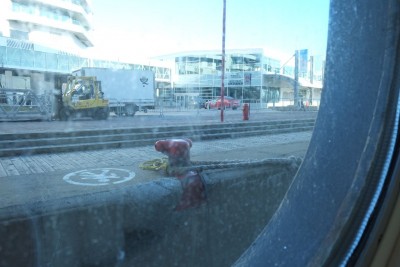
Then, people began to unload pallets of food from delivery trucks.
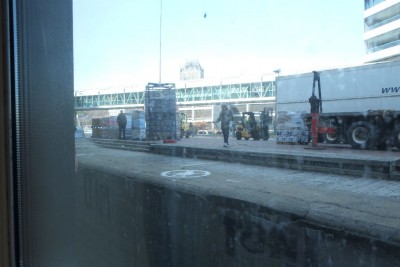
They set cranes in place beside the ship.
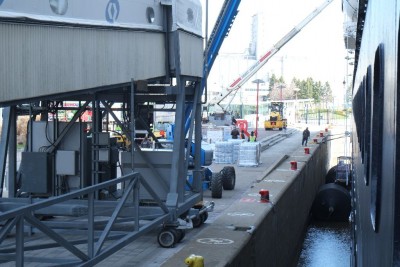
Here is another food truck that a driver brought to the dock.
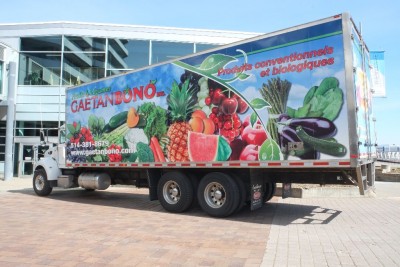
While some workers unloaded our food, others washed our windows.

A forklift driver took pallets off a truck.

He drove the forklift to the edge of the dock.
Security workers watched to make sure that the deliveries were what they were supposed to be.
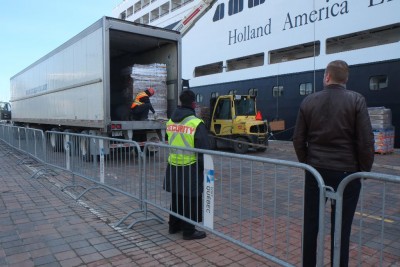
One security worker and his security dog checked the pallets for explosives.
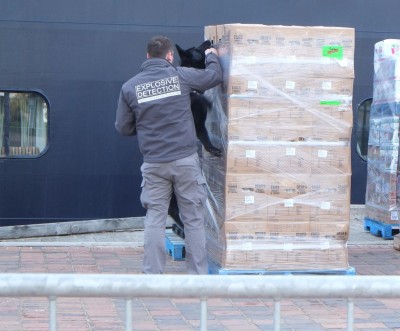
With plywood over the nearest window to make sure it didn’t get broken, a worker watched over the bundles of food as a crane operator lifted them to the waiting portal several decks up.
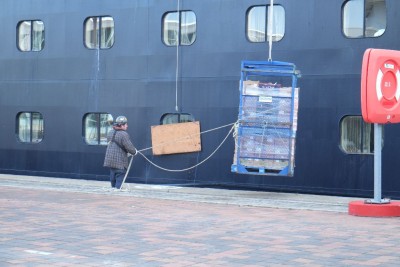
I appreciate every person who worked together to make sure I had dinner that night in Quebec City. It certainly took a lot of them!
One of the purposes of education is to teach children the backstory. When God inspired Moses to write the Pentateuch–Genesis, Exodus, Leviticus, Numbers, and Deuteronomy–before the Israelites went into the Promised Land, He started with the backstory. He began with the week of Creation and continued on through the ancestors of the Israelites, beginning with Abraham.
God’s telling of how He created the world reveals the value of every human being. We all have the same ancestors. God has made us all in His image. God created us to need one another, as is evidenced by Adam needing Eve.
Michael’s grandmother must enjoy being needed. The company who uses her aprons could probably find usable aprons someplace else, but evidently the ones she makes are exactly what they need since they buy so many. I don’t think her extended family would go hungry if she didn’t cook for them every Sunday and Wednesday, but those meals wouldn’t be the same as gathering around Grandmother’s table with their family.
Children need:
- To know they are needed,
- To accept the fact that they need others, and
- To honor those who supply their needs, especially their Father in heaven.
And my God will supply all your needs
according to His riches in glory in Christ Jesus.
Philippians 4:19


Lovely story! And if your family doesn’t live in the local area, you invite others who need family and treat them as if they were your family. 🙂
Wonderful idea, Olive. You are so good at that.